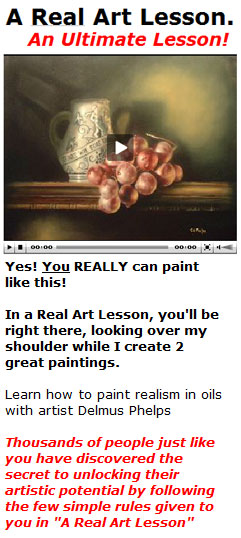Posted by admin | Under brushes, General
Sunday Apr 25, 2010
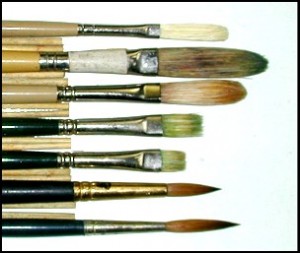 Old-fashioned brushes were much longer, in length of hair and of handle, than their modern equivalents. Renaissance artists had brushes that they could flourish in a way that only orchestral conductors can now enjoy.
Old-fashioned brushes were much longer, in length of hair and of handle, than their modern equivalents. Renaissance artists had brushes that they could flourish in a way that only orchestral conductors can now enjoy.
Still, for outdoor painters, it is probably less romantic but more practical to have brushes that can be held comfortably and easily, with the clipped hair which comes from short-haired animals.
Short or long, the most important points about oil brushes are having enough of them and keeping them soft and flexible. Read the rest of this entry »
Posted by admin | Under General, Oil Painting
Saturday Apr 24, 2010
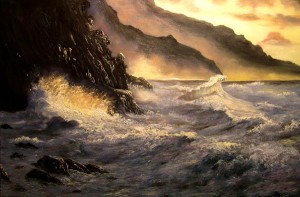 In the early spring, if you take your sketch pad to one of the off-shore islands along the coast of Maine, there is one thing you will come to know and to live with fog. When the visibility drops below a mile or so, you can be sure the foghorn will start pumping its low, mournful blast with a prearranged pattern. By checking this pattern on their charts, the vessels approaching the island will know exactly what landfall they have made. They may slowly pick their way into the harbor and layover until it clears, or they may pass by, never seeing the land where the friendly warning sounds of the horn emanated. A newcomer to the island may find this sound and vibration disturbing at first, may even have a sleepless night, but soon the mind accepts the rhythm of the horn and no longer consciously hears it.
In the early spring, if you take your sketch pad to one of the off-shore islands along the coast of Maine, there is one thing you will come to know and to live with fog. When the visibility drops below a mile or so, you can be sure the foghorn will start pumping its low, mournful blast with a prearranged pattern. By checking this pattern on their charts, the vessels approaching the island will know exactly what landfall they have made. They may slowly pick their way into the harbor and layover until it clears, or they may pass by, never seeing the land where the friendly warning sounds of the horn emanated. A newcomer to the island may find this sound and vibration disturbing at first, may even have a sleepless night, but soon the mind accepts the rhythm of the horn and no longer consciously hears it.
In the springtime along the coast of New England (and England too), one can expect all types of weather to occur in a short span of time-rain, snow, cold, warmth, sun and fog. If the artist loves change, this is the time and place for it. This is the time, too, when the heavy oceans and fog combine to give the artist a quality of mystery and composition that is both strong and yet can be very subtle-a wonderful time to study shapes and reflections and the unexpected. Read the rest of this entry »
Posted by admin | Under General, Oil Painting
Friday Apr 23, 2010
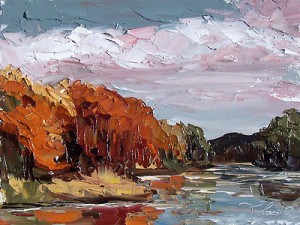 There are of course innumerable kinds of landscapes. Indeed, one of the joys in painting them is the freedom to choose this particular topography or that genus of shrub, this sort of weather or that thickness of cloud. Sometimes the mere inclusion of a faintly drawn person or wisp of smoke from an unseen chimney can change the whole character of your work. As your proficiency in landscapes increases, so too will your pleasure in their immense variety.
There are of course innumerable kinds of landscapes. Indeed, one of the joys in painting them is the freedom to choose this particular topography or that genus of shrub, this sort of weather or that thickness of cloud. Sometimes the mere inclusion of a faintly drawn person or wisp of smoke from an unseen chimney can change the whole character of your work. As your proficiency in landscapes increases, so too will your pleasure in their immense variety.
Of course this variety also presents something of a problem, namely, which sort of a landscape should I choose for this instruction? I decided, first of all, that trees are indispensable, though many of my customers do enjoy seascapes as well. Yet seascapes would involve additional complications that would stretch the scope of this article. I decided that a good compromise would be to do trees along a river bank. That way we can practice all the rudiments of a good landscape: grass, trees, sky and water. Read the rest of this entry »
Posted by admin | Under General
Thursday Mar 4, 2010
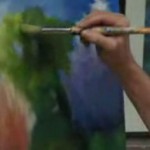
Scumbling
Scumbling is painting thin layers of opaque light color over dark colors, which gives a broken color effect. Scumbling is rather like glazing, but with light colors over dark. The colors mix optically rather than on the palette, and the result is shimmery, opalescent.
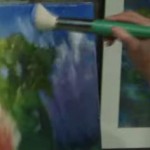
Stippling
Stippling is similar to scumbling but you are adding more texture than contrast. Same strokes of paint but you are working for a texture effect instead of a color effect.
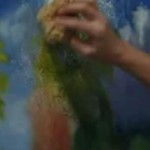
Sponging
Is using a seas spong to create dimensional paint. It is similar to stippling but you are using a thicker surface and creating a more dynamic color and texture effect.
Read the rest of this entry »
Posted by admin | Under General
Thursday Feb 25, 2010
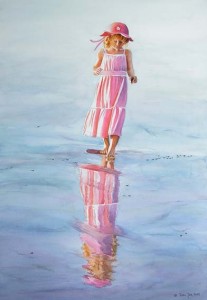 Painting reflections is a lot easier than you think. It is basically a distorted version of the environment of the reflector. If you are painting the three dimensional world then you must first determine the perspective of the reflector. You must first determine if the reflected surface is a smooth surface or a rough surface. The more rough the surface the more distorted the reflection. In the case of the painting to the right the reflection is slightly distorted. This means it is representing a calm surface of water on the beach. The painting to the left is also a water reflection but the water reflection is more rough, so the reflection is more distorted. It is that simple when it comes to water. Read the rest of this entry »
Painting reflections is a lot easier than you think. It is basically a distorted version of the environment of the reflector. If you are painting the three dimensional world then you must first determine the perspective of the reflector. You must first determine if the reflected surface is a smooth surface or a rough surface. The more rough the surface the more distorted the reflection. In the case of the painting to the right the reflection is slightly distorted. This means it is representing a calm surface of water on the beach. The painting to the left is also a water reflection but the water reflection is more rough, so the reflection is more distorted. It is that simple when it comes to water. Read the rest of this entry »
 Old-fashioned brushes were much longer, in length of hair and of handle, than their modern equivalents. Renaissance artists had brushes that they could flourish in a way that only orchestral conductors can now enjoy.
Old-fashioned brushes were much longer, in length of hair and of handle, than their modern equivalents. Renaissance artists had brushes that they could flourish in a way that only orchestral conductors can now enjoy. In the early spring, if you take your sketch pad to one of the off-shore islands along the coast of Maine, there is one thing you will come to know and to live with fog. When the visibility drops below a mile or so, you can be sure the foghorn will start pumping its low, mournful blast with a prearranged pattern. By checking this pattern on their charts, the vessels approaching the island will know exactly what landfall they have made. They may slowly pick their way into the harbor and layover until it clears, or they may pass by, never seeing the land where the friendly warning sounds of the horn emanated. A newcomer to the island may find this sound and vibration disturbing at first, may even have a sleepless night, but soon the mind accepts the rhythm of the horn and no longer consciously hears it.
In the early spring, if you take your sketch pad to one of the off-shore islands along the coast of Maine, there is one thing you will come to know and to live with fog. When the visibility drops below a mile or so, you can be sure the foghorn will start pumping its low, mournful blast with a prearranged pattern. By checking this pattern on their charts, the vessels approaching the island will know exactly what landfall they have made. They may slowly pick their way into the harbor and layover until it clears, or they may pass by, never seeing the land where the friendly warning sounds of the horn emanated. A newcomer to the island may find this sound and vibration disturbing at first, may even have a sleepless night, but soon the mind accepts the rhythm of the horn and no longer consciously hears it. There are of course innumerable kinds of landscapes. Indeed, one of the joys in painting them is the freedom to choose this particular topography or that genus of shrub, this sort of weather or that thickness of cloud. Sometimes the mere inclusion of a faintly drawn person or wisp of smoke from an unseen chimney can change the whole character of your work. As your proficiency in landscapes increases, so too will your pleasure in their immense variety.
There are of course innumerable kinds of landscapes. Indeed, one of the joys in painting them is the freedom to choose this particular topography or that genus of shrub, this sort of weather or that thickness of cloud. Sometimes the mere inclusion of a faintly drawn person or wisp of smoke from an unseen chimney can change the whole character of your work. As your proficiency in landscapes increases, so too will your pleasure in their immense variety.


 Painting reflections is a lot easier than you think. It is basically a distorted version of the environment of the reflector. If you are painting the three dimensional world then you must first determine the perspective of the reflector. You must first determine if the reflected surface is a smooth surface or a rough surface. The more rough the surface the more distorted the reflection. In the case of the painting to the right the reflection is slightly distorted. This means it is representing a calm surface of water on the beach. The painting to the left is also a water reflection but the water reflection is more rough, so the reflection is more distorted. It is that simple when it comes to water.
Painting reflections is a lot easier than you think. It is basically a distorted version of the environment of the reflector. If you are painting the three dimensional world then you must first determine the perspective of the reflector. You must first determine if the reflected surface is a smooth surface or a rough surface. The more rough the surface the more distorted the reflection. In the case of the painting to the right the reflection is slightly distorted. This means it is representing a calm surface of water on the beach. The painting to the left is also a water reflection but the water reflection is more rough, so the reflection is more distorted. It is that simple when it comes to water. 